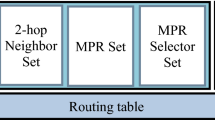Abstract
This paper is motivated by the observation that traditional ad hoc routing protocols are not an adequate solution for messaging applications (e.g., e-mail) in mobile ad hoc networks. Routing in ad hoc mobile networks is challenging mainly because of node mobility – the more rapid the rate of movement, the greater the fraction of bad routes and undelivered messages. For applications that can tolerate delays beyond conventional forwarding delays, we advocate a relay-based approach to be used in conjunction with traditional ad hoc routing protocols. This approach takes advantage of node mobility to disseminate messages to mobile nodes. The result is the Mobile Relay Protocol (MRP), which integrates message routing and storage in the network; the basic idea is that if a route to a destination is unavailable, a node performs a controlled local broadcast (a relay) to its immediate neighbors. In a network with sufficient mobility – precisely the situation when conventional routes are likely to be non-existent or broken – it is quite likely that one of the relay nodes to which the packet has been relayed will encounter a node that has a valid, short (conventional) route to the eventual destination, thereby increasing the likelihood that the message will be successfully delivered. Our simulation results under a variety of node movement models demonstrate that this idea can work well for applications that prefer reliability over latency.
Similar content being viewed by others
References
J. Broch, D. A. Maltz, D. Johnson, Y. Chu and J. Jetcheva, A performance comparison of multi-hop wireless ad hoc network routing protocols, in: Proc. of 4th ACM MobiCom (October 1998).
M. Grossglauser and D. Tse, Mobility increases the capacity of ad-hoc wireless networks, in: Proc. of IEEE INFOCOM (April 2001).
D. Johnson and D. Maltz, Dynamic source routing in ad-hoc wire-less networks, in: Mobile Computing,eds.T. Imielinski and H. Korth (Kluwer Academic Publishers, 1996) pp. 153–181.
D. Kotz, R. Gray, S. Nag, D. Rus, S. Chawla and G. Cybeno, Agent Tcl: Targetting the needs of mobile computers, IEEE Internet Computing (July/August 1997).
Q. Li and D. Rus, Sending messages to mobile users in disconnected ad-hoc wireless networks, in: Proc. of 6th ACM MobiCom (August 2000).
ns-2 (network simulator and nam network interface), http://www. isi.edu/nsnam/ns/
V. D. Park and M. S. Corson, A highly adaptive distributed routing algorithm for mobile wireless networks, in: Proc. of IEEE INFOCOM (April 1997).
C. Perkins and P. Bhagwat, Highly dynamic destination-sequenced distance-vector routing (DSDV) for mobile computers, in: Proc. of ACM SIGCOMM (October 1994) pp. 234–244.
C. E. Perkins and E. M. Royer, Ad hoc on demand distance vector (AODV) algorithm, in: Proc. of 2nd IEEE Workshop on Mobile Computing Systems and Applications (WMCSA) (February 1999).
W. Zhao and M. Ammar, Message ferrying: Proactive routing in highly-partitioned wireless ad hoc networks, in: Proc. of IEEE Work-shop on Future Trends in Distributed Computing Systems (May 2003).
Author information
Authors and Affiliations
Rights and permissions
About this article
Cite this article
Nain, D., Petigara, N. & Balakrishnan, H. Integrated Routing and Storage for Messaging Applications in Mobile Ad Hoc Networks. Mobile Networks and Applications 9, 595–604 (2004). https://doi.org/10.1023/B:MONE.0000042498.60917.e8
Issue Date:
DOI: https://doi.org/10.1023/B:MONE.0000042498.60917.e8




